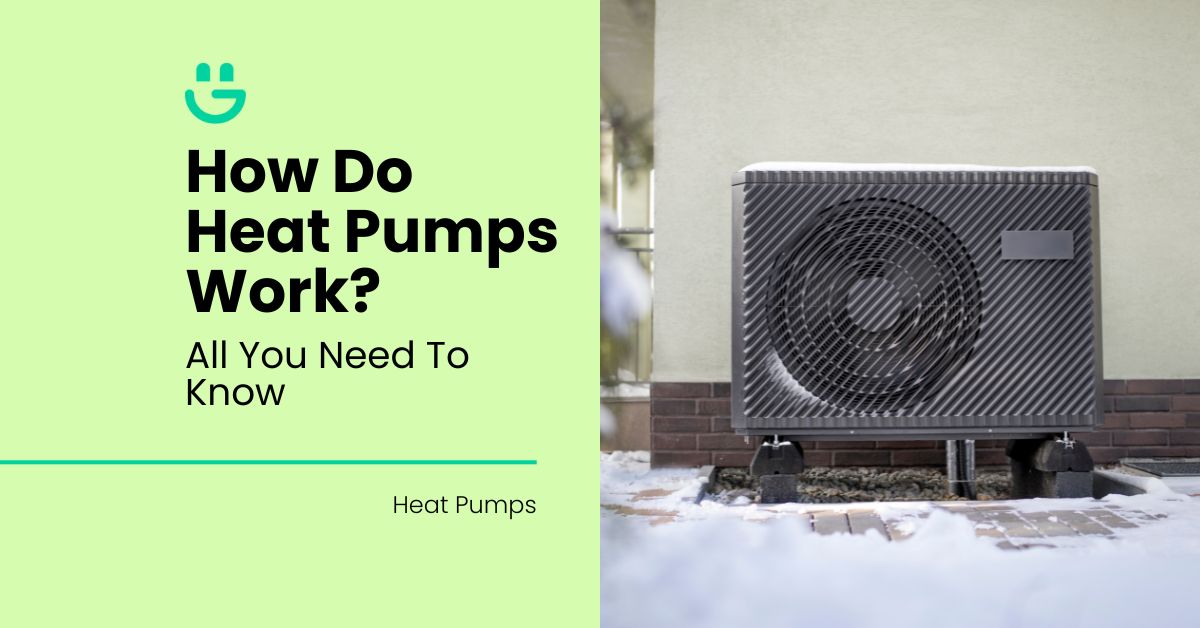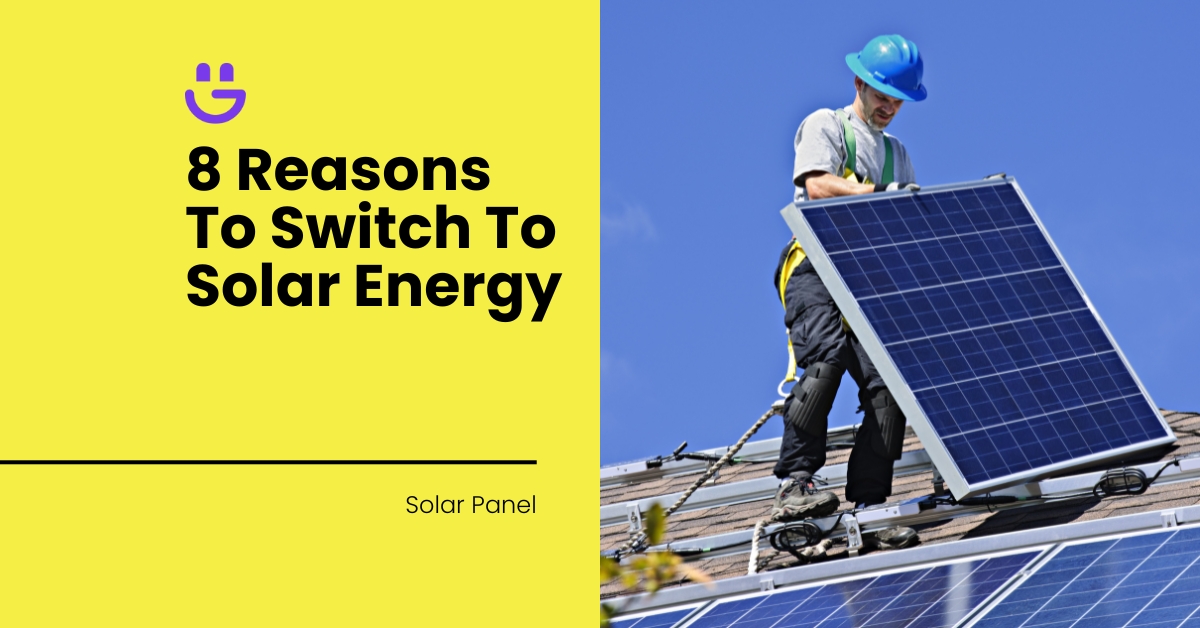Last Updated on June 9, 2025
Heat pumps work using the basic principles of the refrigeration cycle. Instead of using energy to generate heat or cold, this process transfers thermal energy from one environment to another.
Heat pumps extract heat directly from the air, earth, or water. The sun irradiates the earth with an average of 1,000W of energy per square metre – enough to power most appliances. Harnessing that energy is tricky, but heat pumps manage to do this at scale.
In this article, we will look at the seven basic steps every heat pump performs to produce its energy-efficient functions. We will also look at the various types of heat pumps, how they differ from boilers, and how they offer maximum energy efficiency to consumers.
Contents
- 1 The 7 Steps Of The Heat Pump Cycle
- 2 Types Of Heat Pumps
- 3 Heat Pumps vs Boilers
- 4 What Do I Need To Know Before Getting A Heat Pump?
- 5 Heat Pumps And Energy Efficiency
- 6 How Do Heat Pumps Affect Your Carbon Footprint?
- 7 Are Heat Pumps Popular In The UK?
- 8 Advantages Of Heat Pumps
- 9 Disadvantages Of Heat Pumps
- 10 What Is The Best Type Of Heat Pump To Get?
- 11 FAQs
- 12 Conclusion
The 7 Steps Of The Heat Pump Cycle
A heat pump’s cycle of heating and cooling is a reversible process. This means that it will extract heat from the cold air in winter to warm your home. In the summer, it will draw heat from inside your home and move it to the outside, cooling your home. This basic process can be employed in a variety of ways to make a heat pump work, whether they are air, water, or ground source pumps.
At the heart of the system is a refrigerant liquid and a heat exchanger. The refrigerant liquid has a low boiling point and is kept at a low temperature so it remains a liquid until it starts drawing heat from a source.
Here’s the step-by-step process of how a heat pump works:
- Cold refrigerant fluid is pumped along the pipework to the heat exchanger. The pipework runs through the source from which you want to draw heat. As the refrigerant runs through a warmer area, it begins to extract the heat from the surroundings.
- As the refrigerant heats up, the liquid evaporates and expands into a warmer gas. Due to the special properties of the refrigerant fluid, it does not need a lot of heat to start boiling.
- This gas moves through the heat pump to a compressor. Here it is placed under high pressure, pushing the gas atoms closer together and causing it to warm up even more.
- The now much warmer refrigerant gas moves to another heat exchanger within the heat pump system. This heat exchanger is in the area you want to transfer heat to, be that your living room or your wet central heating system.
- The heat is drawn out of the gas as it moves through the heat exchanger.
- Once the heat is transferred out of the refrigerant gas, it will cool and condense back to its colder liquid state.
- The process starts again as the refrigerant liquid returns to step one.
Types Of Heat Pumps
In principle, a heat pump can work anywhere where you can draw from a thermal differential. This is due to a physical property of nature that makes heat move freely from a hot area to a cold area.
Let’s take a look at the main types of heat pumps and how they work.
Ground source heat pumps
Ground source heat pumps (GSHP), also known as geothermal heat pumps, extract heat from the ground. The major benefit is that the ground temperature is pretty stable throughout the year. It is less affected by extreme hot or cold temperatures on the earth’s surface, compared to other heat pumps.
A GSHP lays loops of piping directly into the ground to access heat. These loops are made of High-Density Polyethylene and filled with a mixture of water and antifreeze – the material used to perform the heat transfer from the ground to the heat exchanger.
There are two types of loop systems:
1. Horizontal loop system
The piping loops are placed horizontally in trenches dug into the ground. They need more space to be installed, but due to the shallow nature of the trenches, they are cheaper to install than vertical loop heat pumps.
This system is used, for example, if the soil below your property has bedrock close to the surface, making it unfit for a vertical loop system.
2. Vertical loop system
The loops are installed vertically, requiring excavation directly down. This is more expensive but may be necessary if you do not have much space on your property. If there is no room for horizontal trenches, you need to dig as deep as 100 metres.
Air source heat pumps
Air source heat pumps (ASHP) are often described as reverse air conditioning units. They use many of the same parts as air conditioners and they are generally very small and compact. This has made them the most common type currently in use, making up 10% of worldwide heating solutions.
An air source heat pump uses the same basic refrigeration cycle described earlier. The refrigerant liquid is passed through the pipework. This draws heat from the outside air, carrying it through the heat pump system to an indoor heat exchanger where it is transferred to the central heating system or used to heat water. The cycle repeats to make the heat pump work.
Two ASHP systems can be used for a building:
1. Air to air
In an air-to-air heat pump configuration, a fan is blown across the heat exchanger coils, absorbing the heat from outside and distributing it through the building. These units can only produce warm air and work well as a replacement for an air conditioner.
2. Air to water
In an air-to-water heat pump, the heat from outside is transferred to your wet central heating system. Air source heat pump systems are cooler than a standard boiler setup. Often, this setup will require you to install larger radiator panels or underfloor heating to get the most heat out.
This is because the larger the heat exchange surface of an object, the better the heat transfer. Larger radiators with more panels will transfer more heat to your room. Additionally, underfloor heating turns the whole floor into a heat exchange surface. Both help an air source heat pump heat more effectively.
Hybrid heat pumps
Hybrid heat pumps combine a boiler and a heat pump so that you get the benefits of each.
Hybrid heat pump systems consist of a main heat pump with a boiler functioning as the backup. These systems are designed to work together and provide you with heating on demand while maximising energy efficiency. They communicate with each other through sensors and controls to make the integration seamless.
When a peak heat demand is reached, the hybrid system will switch from the heat pump to the boiler unit to increase heat production until demand decreases and the system reverts to the energy-efficient heat pump.
The great benefit of hybrid heating systems is that they can be integrated with current heating solutions. This is very attractive to consumers who want to switch to a climate-friendly heating solution, but who also want the option to produce high heat on demand.
Water source heat pumps
Water source heat pumps (WSHP) work in the same way as ground and air source pumps; they just use water as their heat source. While this type of heat pump has all the same features and overall benefits as the others, it has more limited applications when it comes to location.
A building will need access to a large body of water, such as a river, lake or well. This makes these heat pumps less common and less practical for large-scale applications in the UK.
It should also be taken into consideration that both heat and cold will be transferred to and from the body of water being used, which may have ecological implications. For example, warming a lake’s water could increase algae blooms, suffocating fish and other aquatic animals.
Heat Pumps vs Boilers
Heat pumps work by transferring heat energy while boilers work by generating it. This means there is a limit to the maximum amount of warmth or cold a heat pump can transfer into a building over time.
For example, with a boiler, you can turn up your thermostat to warm a cold home quickly. With a heat pump, the system will keep a constant, even flow of heat or cold to bring your home or building up to a comfortable temperature over time.
What Do I Need To Know Before Getting A Heat Pump?
- Heat pump systems and boilers both benefit from being installed in a well-insulated home. This is especially true for heat pumps, as they cannot generate as much on-demand heat as a boiler.
- It is a good idea to have a professional heat pump installer evaluate your home and heating needs. You can contact Eco Happy to get the best quote comparisons for heat pump installers in your area.
- Heat pumps send water through central heating systems at lower average temperatures, between 35 ℃ and 45 ℃. Compare this to a boiler, which heats hot water to 75 ℃.
- As mentioned earlier, by increasing the available surface area of your radiators, you can increase the amount of heat transfer. So, to get the best performance from a heat pump installation, you would want to upgrade your radiators to double or triple-panelled models.
- If you do not use underfloor heating, it may be helpful to install some. By warming the surface of your floor using a heat pump, it will transfer more thermal energy to your home.
- Heat pumps run about as loud as a refrigerator, which is a bit louder than most boilers. It is not an unreasonable noise level and should cause no issues after they are installed.
Heat Pumps And Energy Efficiency
To measure a heating or cooling system’s effectiveness, you need to look at the device’s Coefficient of Performance (COP). This is at the heart of how a heat pump works so efficiently. It is a direct measure of the conversion of units of energy to units of temperature, or heat energy.
For example, if you take a standard resistance bar heater, the COP is 1. So, for every unit of energy used, you will receive 1 unit of heat. An A-rated boiler has a COP of around 0.8. Heat pumps, by comparison, have a COP ranging between 2.5 and 5.
Because the COP is an averaged figure, air source heat pumps have a lower COP compared to other heat pumps. ASHPs need to contend with the changing weather, affecting their average efficiency throughout the year.
On the other hand, a ground source heat pump is not subjected to large temperature fluctuations like air source heat pumps. The ground temperature remains pretty constant, making their coefficient of performance higher.
The refrigeration liquid used is a major reason for heat pump efficiency. The refrigerant material can transfer 50 times more energy than air and 10 times more energy than water. This allows the system to transfer as much heat as possible during operation.
Another reason for a heat pump’s amazing efficiency is that it transfers heat rather than generates it. Heat naturally moves to colder areas, so there is no energy needed to transfer the heat – it moves by the laws of nature.
How Do Heat Pumps Affect Your Carbon Footprint?
Heat pump systems lower your overall carbon footprint. However, they do use electricity, which is still generated from coal and natural gas in the UK. The heat pump itself does not burn any fossil fuels during operation and it is almost five times as effective in turning electricity into heat energy compared to a boiler.
A ground source heat pump uses heat transfer loops made of high-density polyethylene, or HDPE. This is a recyclable material that is also used to make plastic bottles. This makes installing a heat pump possible with greener materials.
On the downside, heat pumps use Hydrofluorocarbons (or HFCs) as their refrigerant material. HFCs are greenhouse gases that can leak out over time. That said, they are still far less polluting than fossil fuel boilers.
Are Heat Pumps Popular In The UK?
Yes, heat pumps are gaining more and more popularity in the United Kingdom thanks to government support. As the UK is aiming to reach carbon neutrality by 2050, heat pumps have stood out as an efficient and emission-free replacement for fossil fuel boilers.
Heat pumps have been in use throughout Europe for years and in much more extreme climates than the UK. It is a tried and tested heating solution for hot water or home heating. Advancements in heat pump technology are also increasing as more companies invest in research and development of this green tech.
With the UK’s rising energy prices, people are looking for cheaper ways to heat and cool their homes. Heat pumps look like they will be the answer to that call. While the costs attached are still a hurdle, government grants have made transitioning from boilers to heat pumps much more affordable.
How a heat pump works in winter
A heat pump works in winter just as well as it does in summer. The refrigeration liquid used in a heat pump is generally much colder than the outside air, soil, and water. This means there is always heat to be extracted, even if outside temperatures fall to -10 ℃. However, low temperatures will affect overall efficiency.
Geothermal heat pumps are more resistant to the whims of the climate. A GSHP gets pretty much year-round optimal operating temperatures from its buried looped piping. This insulating effect of the ground lets the heat pump work in all climates.
Advantages Of Heat Pumps
Let’s look at why heat pumps receive so much government and industry support.
- A heat pump produces incredibly low emissions of greenhouse gases compared to a natural gas boiler. The system uses electricity in a highly efficient manner to produce much more heat and cold output than has been put in as electric energy.
- Heat pumps can heat and cool using the same unit, making it an all-in-one solution for summer and winter months.
- Heat pumps are a lot safer than boilers. They don’t make use of combustion and natural gas to perform their function. They pose no risk of poisonous emissions, unlike gas boilers that can leak carbon monoxide.
- The average lifespan for a heat pump is between 15 and 20 years. With annual maintenance, they can deliver decades of hot water and heating.
- A heat pump is a complex heating and cooling device but it requires far less maintenance than a boiler. Boilers have more moving parts and potential points of failure.
- An air source heat pump is simple to install and does not take up much space. They are generally the size of a standard air conditioning unit.
Disadvantages Of Heat Pumps
Let’s discuss some of the downsides to heat pumps.
- The biggest downside to heat pumps is that you cannot turn the thermostat up to the highest setting to warm your home quickly. Heat pumps are designed to deliver even, comfortable temperatures throughout the day.
- Heat pumps are very expensive. Even standard models are much more expensive than a top boiler.
- Air source heat pumps are affected by the weather. The colder it is outside, the less efficient the heat pump becomes.
- A ground source heat pump requires a complex and expensive installation.
- With current electricity prices in the UK, a heat pump can be expensive to run compared to a gas boiler.
What Is The Best Type Of Heat Pump To Get?
Apart from the benefits of different systems, this choice can depend on your budget. While there is no VAT added to heat pumps and there are government grant schemes you may qualify for, they are still quite costly.
Air heat pumps are great for apartments and flats. They are a simple solution that’s easy to install in an apartment complex and it won’t make much noise. A heat pump is the perfect replacement for an existing air conditioner. Air to air pumps are also great for your hot water needs.
A ground source heat pump is ideal for people with semi-detached and freestanding homes. You need some yard space where trenches of the coil loops can be installed underground. Additionally, they likely require planning permissions due to the digging required for the installation.
If you want to know more about the different heat pump brands out there you can check out this helpful heat pump brand guide.
FAQs
How much do heat pumps cost?
Purchase and installation of air heat pumps can run as much as £6,000 – £10,000. GSHPs can cost as much as £20,000 due to the need for excavation. That is not taking into account that you may wish to upgrade your radiators or install underfloor heating. Learn more about the costs involved in our heat pump cost guide.
Are heat pumps worth it?
From an ecological perspective, yes – heat pumps are worth it. They cannot be beaten for low emission, high-efficiency hot water delivery, heating and cooling. Due to the high COP of a heat pump’s operation, you get more heat produced for the same amount of energy input than other heating solutions.
Heat pumps still need to use electricity to operate though. With the cost of energy bills in the UK currently, it won’t mean drastic savings on heating bills.
Conclusion
Heat pumps are seen as an excellent replacement for fossil fuel boilers in the UK. While there are still some challenges to overcome, you can’t argue with the efficient hot water and heat produced.
Current major challenges are still high installation costs and running costs compared to boilers. These issues will become much less of a concern over time as technology improves and the market expands.
Request a free air source heat pump quote today.






James Elston
Boiler Expert
James Elston is the top boiler replacement and heating expert at Eco Happy. He has over 20 years of experience in the industry, focusing on Gas Safe boiler installations and offering home-heating and energy-saving solutions to homeowners across the UK. From sourcing the most energy-efficient combi boiler to providing specialist heating advice, James ensures that Eco Happy maintains the highest standards and best customer service.